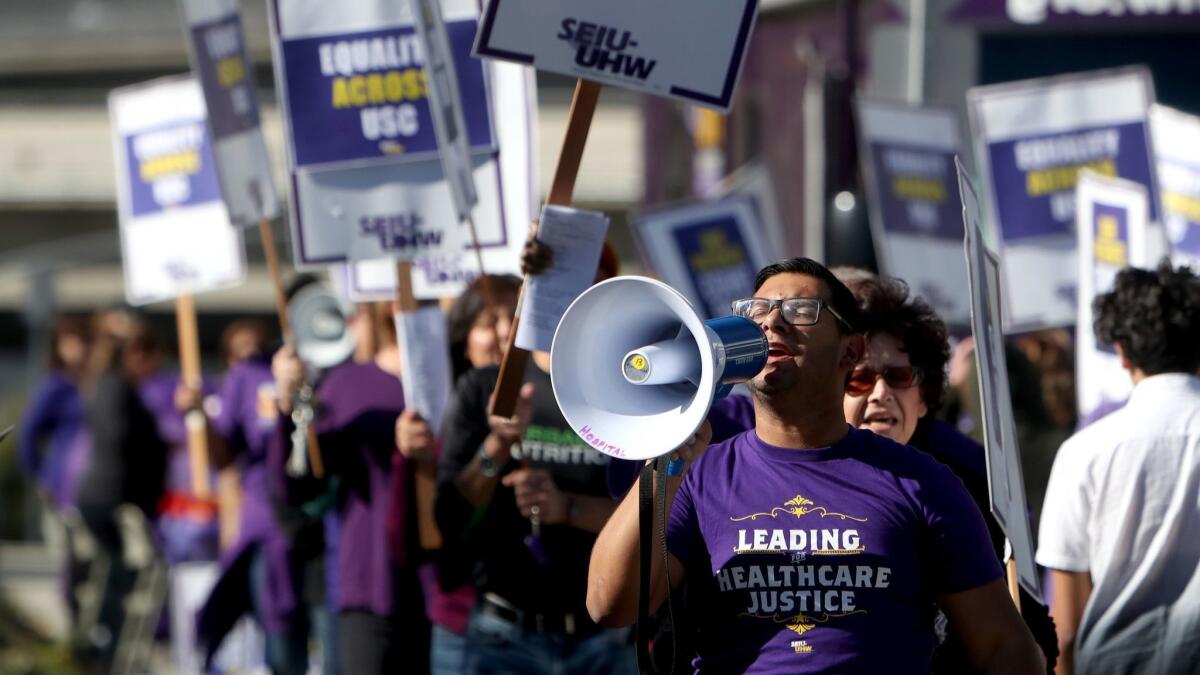USC Verdugo Hills health-care workers picket, threaten strike, alleging unfair treatment

- Share via
“No contract, no peace,” chanted several dozen health-care employees and their union representatives outside USC Verdugo Hills Hospital Wednesday, slicing through an otherwise quiet morning.
Picketers claimed hospital management officials have been dragging their feet during negotiations for a proposed contract that includes employees’ requests for increases in pay and staffing, as well as free health care, for workers represented by Service Employees International Union-United Healthcare Workers West, known as SEIU-UHW.
“Everything has just been pushed back. We presented our proposal, but they haven’t responded to anything,” said Carlos Martinez, a nursing assistant who has worked at the hospital for seven years.
A bargaining meeting held the day before the picket did not result in meaningful progress, and no firm follow-up date has been set, Martinez said.
The existing contract is set to expire Jan. 31.
If the agreement continues to stall, Martinez said there would likely be additional picketing and even a potential strike.
Hospital management, including chief executive Keith Hobbs, declined to comment through a spokesperson.
Meanwhile, as workers marched and bullhorns blared outside the hospital, surgical buyer Andrew Brown held a simultaneous anti-union gathering in one of the hospital’s conference rooms.
Since October, Brown has been fighting to dissolve the union formed three years ago, when he filed a petition that was rejected by the National Labor Relations Board, or NLRB, because it arrived two days too late.
According to Brown, he has the support of a majority of the 230 workers in the bargaining unit, which includes patient services representatives, obstetrics technicians and phlebotomists.
He plans to resubmit a petition on Jan. 2 — the earliest date he can.
“What the union was telling us was lies... and the majority of the people in the unit have realized that,” said Brown, referring to what he said was an unfulfilled promise by union leaders to secure 5% pay raises.
Grisell Rodriguez, who is leading SEIU’s field campaign for the contract, said hospital management promised employees the same raise if they voted to dissolve the union.
“If an employer wanted to give a 5% raise, they wouldn’t be stalling on the proposal that we gave,” Rodriguez said.
Pointing out that a decertification petition requires only 30% of a bargaining unit’s support to file, Rodriguez also dismissed Brown’s claim to have a majority of workers behind him.
Over the course of the contentious battle that has been playing out between pro- and anti-union forces at the hospital since Brown filed his petition, Hobbs has said several times that he supports all employees, whether they want representation or not.
Inheriting a financially failing hospital in January 2016, Hobbs in October said the morale was low all around the medical facility.
He previously said he’s helped instill a cultural and financial shift by cultivating personal relationships and introducing meritocratic raises.
Now “they feel they have enough trust in leadership that they don’t need a third party to represent them anymore,” Hobbs said after Brown filed the decertification petition.
On Wednesday, Martinez denied having that type of relationship with the relatively new management.
“When it comes to my living, and they’re not willing to help me improve that, when I come here and work hard for them, it makes it hard to really trust them,” Martinez said.
The biggest sticking point is low staffing levels, which some of the workers think jeopardizes their safety and the safety of patients, Martinez said, adding that, in particular, there is a need for more personnel psychiatric units.
“When someone is taking care of three patients, as opposed to one, that’s a safety-hazard concern,” Rodriguez said.
No employees showed up at Brown’s lunchtime meeting, which he attributed to a combination of the union’s bullying tactics and the fact that it was difficult for employees to take time off from work.
About 100 employees signed up to take turns marching during the two-hour picket, according to Martinez. Roughly 40 people were marching at any given time.
David Acosta, a consultant not employed by the hospital and the only attendee at Brown’s meeting, questioned whether the majority of the marchers were hospital employees, suggesting they could be union employees or paid protesters.
Twitter: @lila_seidman
